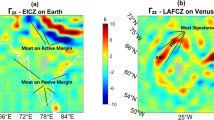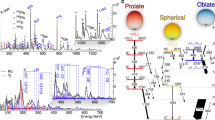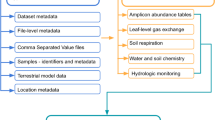Abstract
IN a paper to be published elsewhere, I have derived the ormula:  where η is a measure of departure from chemical homogeneity at depth z in the Earth (here treated as spherically symmetrical); k, p and g denote the adiabatic incompressibility, pressure and intensity of gravitational attraction, and Φ is a function of the P and S seismic velocities. The index η is equal to unity where the Earth is chemically homogeneous, in accordance with a simpler formula1 developed in 1949; η exceeds unity where the chemical composition is varying with the depth z. An important property of η is that it is equal to the ratio of the actual value of dρ/dz (where ρ denotes density) to the value dρ/dz would take if the composition were unvarying.
where η is a measure of departure from chemical homogeneity at depth z in the Earth (here treated as spherically symmetrical); k, p and g denote the adiabatic incompressibility, pressure and intensity of gravitational attraction, and Φ is a function of the P and S seismic velocities. The index η is equal to unity where the Earth is chemically homogeneous, in accordance with a simpler formula1 developed in 1949; η exceeds unity where the chemical composition is varying with the depth z. An important property of η is that it is equal to the ratio of the actual value of dρ/dz (where ρ denotes density) to the value dρ/dz would take if the composition were unvarying.
This is a preview of subscription content, access via your institution
Access options
Subscribe to this journal
Receive 51 print issues and online access
$199.00 per year
only $3.90 per issue
Buy this article
- Purchase on SpringerLink
- Instant access to full article PDF
Prices may be subject to local taxes which are calculated during checkout
Similar content being viewed by others
References
Bullen, K. E., Mon. Not. Roy. Astro. Soc., Geophys. Supp., 5, 355 (1949).
Bolt, B. A., Nature, 196, 122 (1962).
Jeffreys, H., Mon. Not. Roy. Astro. Soc., Geophys. Supp., 4, 498 (1939).
Bullen, K. E., Mon. Not. Roy. Astro. Soc., Geophys. Supp., 6, 50 (1950).
Author information
Authors and Affiliations
Rights and permissions
About this article
Cite this article
BULLEN, K. Earth's Central Density. Nature 196, 973 (1962). https://doi.org/10.1038/196973a0
Issue date:
DOI: https://doi.org/10.1038/196973a0
This article is cited by
-
Rigidity and Density in the Earth's Core
Nature (1964)



